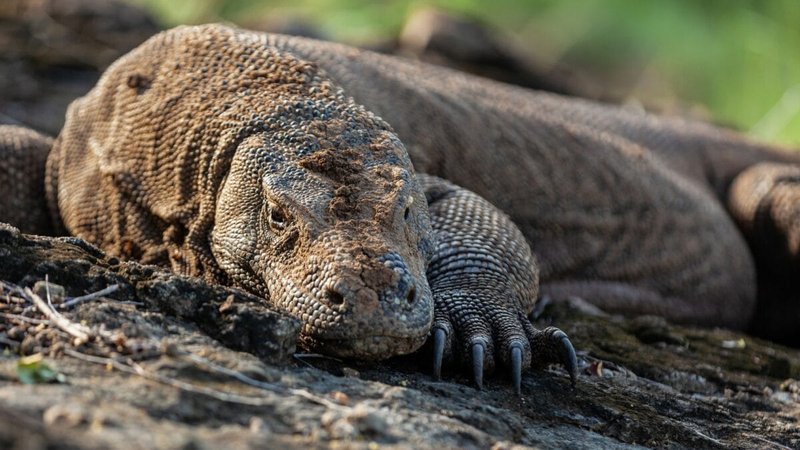
So, how do Komodo dragons manage to live in such harsh conditions? It’s a combination of their physical adaptations, hunting skills, and unique behaviors. Just like a well-designed Swiss army knife, every feature of the Komodo dragon is tailored for survival. Let’s break down the fascinating ways these creatures navigate their tough lives.
The Harsh Habitat of the Komodo Dragon
Komodo dragons inhabit a variety of environments, primarily dry, hot savannas and dense forests. You might think, “How can anything survive in such a place?” The answer lies in their adaptability. These lizards roam the islands of Komodo, Rinca, Flores, and Gili Motang, where temperatures can soar above 100°F (38°C).
In their habitat, the lizards face challenges like limited water sources and intense heat. While many animals would struggle, Komodo dragons have evolved to cope with these extremes. For instance, they can go for long periods without drinking water, extracting moisture from their food. This ability positions them as apex predators and allows them to thrive where other creatures might perish.
Physical Adaptations for Survival
One of the most striking features of the Komodo dragon is its size. They can reach lengths of up to 10 feet and weigh around 150 pounds. This large size isn’t just for show; it’s an adaptation that aids in hunting and offense.
Powerful jaws and a muscular body allow these reptiles to take down prey much larger than themselves, such as deer and wild boar. Their teeth are serrated, almost like knives, making it easier to tear into flesh. But here’s the kicker—there’s more than just sheer strength at play.
Komodo dragons have a unique ability to tolerate high levels of bacteria in their mouths. When they bite their prey, the bacteria can cause infections that weaken the animal, allowing the dragon to track it down later. This hunting strategy proves that survival isn’t just about brute force; it’s also about being clever.
Temperature Regulation and Behavior
Given their hot environment, temperature regulation is crucial for Komodo dragons. These reptiles are ectothermic, meaning they rely on external sources of heat to regulate their body temperature. You might be wondering how they pull this off in the blazing sun.
During the hottest parts of the day, they retreat to the shade or burrows. They often bask in the morning sun to warm up after a cool night. This behavior ensures they have enough energy for hunting and other activities. In the evening, they might become more active, taking advantage of cooler temperatures to stretch their legs and scout for food.
Social dynamics also play a role in their survival. Male Komodo dragons often engage in combat to establish dominance and secure territory. This natural behavior ensures that the strongest genes are passed down, allowing for better adaptation to challenging conditions.
Diet and Hunting Strategies
The diet of a Komodo dragon is as fierce as the creature itself. They are carnivores, primarily feeding on large mammals, but they won’t hesitate to munch on carrion if the opportunity arises. Their hunting strategy is a mix of patience and power.
When hunting, Komodo dragons often lay in wait for hours, camouflaged among the rocks and foliage. Then, with incredible burst speed, they can sprint to catch their prey. Here’s the thing: their sense of smell is highly developed. They can detect foul odors from over a mile away, making them exceptional hunters.
Interestingly, their hunting isn’t just about physical prowess. Komodo dragons are known to employ a strategy called ambush predation. This means they use their environment to hide and surprise their prey, taking advantage of the element of surprise to secure a meal.
Water Conservation and Adaptation
In their dry habitat, water isn’t always readily available. But the Komodo dragon has some exceptional ways to conserve water. As mentioned earlier, they can survive on moisture from their food. This adaptation is crucial during dry seasons when water sources might be scarce.
Moreover, these lizards have a unique way of dealing with dehydration. When food is plentiful, they can eat large meals, storing fat that can be converted into water later. This biological trick is crucial; it means they don’t have to worry as much about finding water daily, allowing them to focus on other survival strategies.
Their skin also plays a role in water conservation. The scales are tough and prevent excessive water loss, which is vital in an environment where every drop counts.
Resilience Against Predators
Despite being apex predators, Komodo dragons still face threats, particularly when they are young. The smaller, juvenile dragons can fall prey to larger birds or even adult dragons. This might seem unfair, but it emphasizes the importance of resilience in a harsh environment.
To combat this, baby Komodo dragons often climb trees to avoid ground-based predators. They remain in the treetops until they are large enough to defend themselves. This behavior is a testament to their survival instincts and a clever adaptation to their surroundings.
Adult dragons also have a few tricks up their sleeves. When threatened, they can use their size and speed to intimidate potential threats. Their fierce appearance, combined with powerful hissing and aggressive body language, often deters many animals from approaching.
The Komodo dragon is a stunning example of how nature molds creatures to thrive in severe environments. From clever hunting strategies to remarkable physical adaptations, each aspect of their lives showcases a will to survive against the odds. They remind us that survival isn’t just about strength; it’s also about adaptability and resilience.
As we learn more about these incredible lizards, we gain insight into the delicate balance of ecosystems and the importance of preserving their habitats. So next time you hear about the Komodo dragon, remember it’s not just a fascinating creature—it’s a master of survival in a world that can be tough to navigate.

